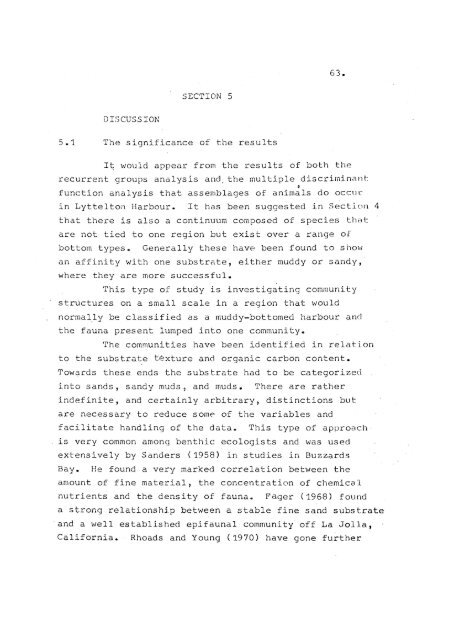The benthic ecology and community structure in Lyttelton Harbour ...
The benthic ecology and community structure in Lyttelton Harbour ...
The benthic ecology and community structure in Lyttelton Harbour ...
Create successful ePaper yourself
Turn your PDF publications into a flip-book with our unique Google optimized e-Paper software.
63.<br />
SECTION 5<br />
DISCUSSION<br />
5.1 <strong>The</strong> significance of the results<br />
I~ would appear from the results of both the<br />
recurrent groups analysis <strong>and</strong>, the multiple discrim<strong>in</strong>al,t<br />
t<br />
function analysis that assemblages of animals do occuc<br />
<strong>in</strong> <strong>Lyttelton</strong> Ilarbour. It has been suggested <strong>in</strong> Section 4<br />
that there is also a cont<strong>in</strong>uum composed of species that<br />
are not tied to one region but exist over a range of<br />
bottom types.<br />
Generally these have been found to show<br />
an aff<strong>in</strong>ity with one substrate, either muddy or s<strong>and</strong>y,<br />
where they are more successful.<br />
This type of study is <strong>in</strong>vestigat<strong>in</strong>g <strong>community</strong><br />
<strong>structure</strong>s on a small scale <strong>in</strong> a region that would<br />
norma~ly<br />
be classified as a muddy-bottomed harbour <strong>and</strong><br />
the fauna present lumped <strong>in</strong>to one <strong>community</strong>.<br />
<strong>The</strong> communities have been identified <strong>in</strong> relation<br />
to the substrate t~xture<br />
<strong>and</strong> organic carbon content.<br />
Towards these ends the substrate had to be categorized<br />
<strong>in</strong>to s<strong>and</strong>s, s<strong>and</strong>y muds, <strong>and</strong> muds.<br />
<strong>The</strong>re are rather<br />
<strong>in</strong>def<strong>in</strong>ite, <strong>and</strong> certa<strong>in</strong>ly arbitrary, dist<strong>in</strong>ctions but<br />
are necessary to reduce some of the variables <strong>and</strong><br />
facilitate h<strong>and</strong>l<strong>in</strong>g of the datao<br />
This type of approach·<br />
is very common among <strong>benthic</strong> ecologists <strong>and</strong> was used<br />
extensively by S<strong>and</strong>ers (1958) <strong>in</strong> stUdies <strong>in</strong> Buzzards<br />
Bay.<br />
He found a very marked correlation between the<br />
amount of f<strong>in</strong>e material, the concentration of chemical<br />
nutrients <strong>and</strong> the density of faunae<br />
Fager (1968) found<br />
a strong relationship between a stable f<strong>in</strong>e s<strong>and</strong> substrate<br />
'<strong>and</strong> a well established epifaunal <strong>community</strong> off La Jolla,<br />
California. Rhoads <strong>and</strong> Young (1970) have gone further
















